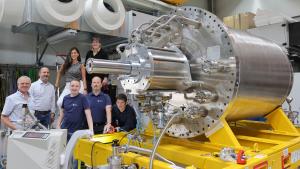First cryopump passes all tests
"This achievement paves the way for delivery of the first cryopump to ITER by the end of the month and seven more by the end of the year," says Robert Pearce, ITER Vacuum System Project Leader.
With a volume of nearly 1,400 m³ and 8,500 m³ respectively, the ITER vacuum vessel and cryostat range among the largest vacuum systems ever built.
To create the very specific vacuum conditions that ITER requires, cryopumps—which "capture" unwanted particles by trapping them on extremely cold surfaces—are indispensable to finalizing the initial pumping done by mechanical devices. ITER will rely on six torus cryopumps to maintain ultra-high vacuum inside the ITER vacuum vessel during operation and to create low density—about one million times lower than the density of air. Two other cryopumps will provide the insulating vacuum in the cryostat that allow the superconducting magnets to remain cold.
All eight are under the procurement responsibility of the European Domestic Agency Fusion for Energy. Research and prototyping have been underway for years; since 2018 the build-to-print procurement package has been in the hands of industry after the delivery of a pre-production cryopump unit for testing and the signature of the Torus and Cryostat Cryopump Procurement Arrangement.


